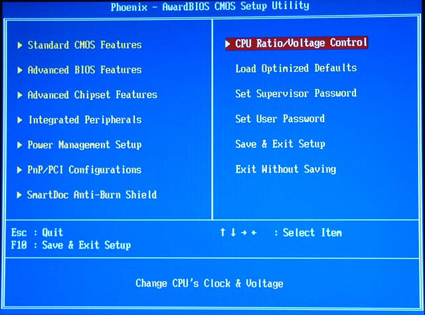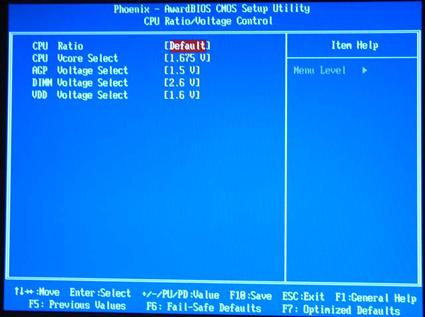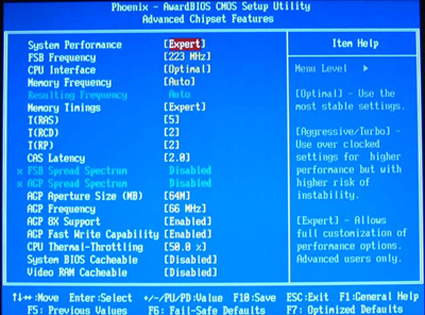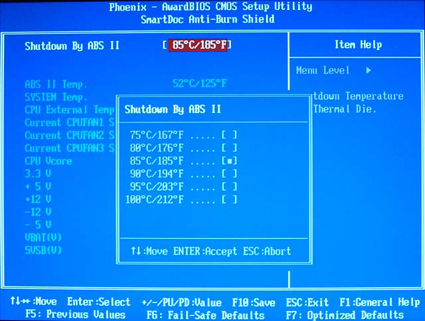Soltek NV400-L64: Purple, Practical, AND Performance!
by Wesley Fink on August 11, 2003 10:26 PM EST- Posted in
- Motherboards
Soltek NV400-L64: BIOS and Overclocking
Soltek uses the familiar Award BIOS on the NV400-L64. Our board was tested with the shipping v1.1 BIOS. The NV400 BIOS will be a pleasant surprise for enthusiasts who want to tweak the Soltek for the best possible performance. The board timing options and overclocking options are much more than you would expect on a low-priced motherboard.
The Main BIOS Screen layout includes the standard options, plus CPU Ratios/Voltage Control, Advance Chipset Features for system timings, and SmartDoc Anti-Burn.

Voltage selection and CPU ratios are adjusted in the CPU Ratios/Voltage Control menu. Voltage adjustments are included for Core Voltage, DIMM, AGP, and also (surprisingly) adjustments for chipset (VDD) voltage.

System and Memory Timings are adjusted in the Advanced Chipset Features menu. Unlike many other boards, the NV400-L64 has the adjustments for FSB in Advanced Chipset Features. A pleasant surprise is that Soltek includes a 'Fixed' option for PCI/AGP speed, which is adjustable from 50-100 AGP (PCI is half this value) in 1 MHz increments. While there is a full range of memory timing adjustments, one area of concern here is the Memory Frequency. The only option available is 'Auto', which means the memory can only be set to the memory speed programmed in the SPD. This will be a disappointment for many who like to adjust memory speeds for best performance.

PC Health functions are featured in the SmartDoc Anti-Burn Shield section. Monitoring functions include System, CPU, and ABSII temperatures, fan speed monitoring for three on-board fan connections, Vcore, and Power Supply readings for all rails. The ABSII temperature monitoring appears to be reporting AMD sensor temperatures, as the reported temperatures are quite a bit higher than reported System temperatures. Soltek includes a Hardware monitoring utility on their installation CD for reporting the values in Windows.

The Anti-Burn Shield II option has adjustments for setting the system shutdown temperature in the event of overheating. With the lack of attention paid to Athlon overheating problems in the past, we are pleased to see this concern addressed by Soltek on a board that will sell into the mainstream market.
BIOS options for the NV400-L64 are surprisingly complete. What we found here is very much in line with Soltek’s reputation of building economical boards that will still satisfy the computer enthusiast.
FSB Overclocking Results
With a complete selection of overclocking options on the Soltek, we had high expectations for the overclocking performance of the board. For FSB overclocking, the following setup was used on the NV400-L64:| Front Side Bus Overclocking Testbed | ||
| Default Voltage | Maximum Overclock | |
| Processor: | Athlon XP 2500+ (Barton Core) | Athlon XP 2500+ (Barton Core) |
| CPU Vcore: | 1.650V (default) | 1.775V (default) |
| Cooling: | Thermalright SK-7 with 80mm Thermaltake Fan | Thermalright SK-7 with 80mm Thermaltake Fan |
| Power Supply: | Powmax 350W | Powmax 350W |
The above overclocking setup at default voltage allowed us to reach a stable FSB of 215MHz. Considering that the DFI NFII Ultra reached a stable 223MHz at the same default settings, we were mildly disappointed in the Soltek overclocking performance compared to the best nForce2 Ultra 400 board. However, when we increased our voltage settings, we were able to reach a stable overclock of 225MHz at 1.775V. While this is not quite as good as the DFI NFII Ultra, it is very close, and it suggests that the Soltek design may require a bit more voltage than higher-end boards to reach the same overclocking heights. Our experience with higher voltages on VDD, in particular, suggests that very high overclocks can be reached with the NV400-L64 — if you are comfortable using higher voltages with this board. With the voltage and adjustment options available on the Soltek, and the low price of the board, we would not be at all surprised to see overclockers modding this board and pushing it to new performance levels. Out of the box, it is a decent, but not outstanding, performer at default voltage. With higher voltages, it becomes one of the best overclocking nForce2 boards that we have tested.
The Soltek NV400-L64 has a wide range of multiplier adjustments, available from 5X all the way up to 22X.










35 Comments
View All Comments
Anonymous User - Saturday, August 16, 2003 - link
Wesley -I thought the PCI bus runs at a fixed frequency and is independent from the AGP bus. In the review, it was stated that the PCI bus is half of the AGP bus. Is it possible that this could be confirmed with a hardware monitor that is capable of measuring the PCI bus speed? If not, from what source was the PCI bus speed information taken from?
Thanx for review! :D
Anonymous User - Friday, August 15, 2003 - link
#23, you're clueless. AnandTech still has the best motherboard, CPU and now memory reviews on the net. HardOCP does some of the best video card reviews on the net, a bit better than AnandTech, but that's mostly because Anandtech doesn't release any individual video card reviews. If they did, Anandtech would dominate CPU, motherboard, video AND memory reviews.Read other web sites before you belittle Anandtech for quality reviews.
LMAO at #24. Though your point could have been made better without the swearing. :)
Anonymous User - Thursday, August 14, 2003 - link
Yeah Well ,This review is slightly amusing &Mildly Boring..
For all you new guys at AnandTech,
This place does not feel like "Home" anymore..
Oh yes ,its still my homepage ,after so many years.
The Place Might be Anand's - But it aint Anandtech no more...
THe reviews are lacking & incomplete - with too much cutting & pasting done all the time.
Many issues are just ignored ,
& it all feels so shallow.......
You Should Go Read "Old" Coppermine Area AnandTech Archives & get a grip on what this place used to be...
Please hear My (our?!) cry ..
Locutus4657 - Thursday, August 14, 2003 - link
#5:What the heck are you talking about? Via? Better Stability?? You've obviously never looked into their white papers before.... More than 200 pages for the KT133 errata section alone. I'm sorry, It's worth getting fewer features for an nForce board. At least it will work.
Anonymous User - Thursday, August 14, 2003 - link
Why is it that drivers get so little attention, but small differences in performance are blown up well beyond reasonable proportions? I'm talking about reviews all over the net now and not just Anandtech. It's just that the nForce drivers continuing mess doesn't get even a tenth of the attention that benchmarks in stupid programs like SiSoft Sandra get. (?!?)Wich bothers the users most, a few percentages here and there that doesn't show in practical use or driver issues that makes the regular user call his or her "techy" friend to come solve the issues.
Anonymous User - Thursday, August 14, 2003 - link
Actually, we are only on a limitted relationship with Crucial, Corsair, Kingston and Mushkin. They all send us lots of products, but its fairly easy to do considering how much (or how little) a stick of DDR costs.Evan Lieb - Tuesday, August 12, 2003 - link
In case anyone is wondering, all nForce2 Ultra 400 motherboards from Epox, ASUS, ABIT, etc. vary on an average of 0-1.5% (max). In fact, Gigabyte's nForce2 Ultra 400 motherboard (7NNXP) was ever so slightly faster than ASUS's A7N8X Deluxe rev. 2.0In other words, it serves no purpose to run benchmarks on 10 different nForce2 Ulra 400 motherboards if they all perform the same (unless it's a roundup of course).
Wesley Fink - Tuesday, August 12, 2003 - link
All our benchmarks are run at 1024x768 and at 32bit color if possible. We run the GunMetal 2 bench at default settings - which is audio enabled and 2X Anisotropic filtering. It has been common practice NOT to run Quake3 and other game benches with sound enabled due to the variation in scores caused by different sound chips. However with this new DX9 bench, we decided to run at default.Unfortunately, GunMetal 2 seems VERY video-card bound, and may not be a very useful benchmark for motherboard testing. It would appear a great choice, though, for testing video cards.
Anonymous User - Tuesday, August 12, 2003 - link
Wesley could you please state what settings the gunmetal benchs were run including the resolution, graphical settings ect.. I would like to compare my setup to your results. This info would be benificial if it was stated in the result graphic in the article. Thanks.Wesley Fink - Tuesday, August 12, 2003 - link
#14 - As we stated in #10 and #12, we recently completed retesting ALL recent reviews with our new ATI 9800 PRO video standard. When that was done, benchmarks for this review were updated and sent to our editor who does web-posting.Unfortunately, our web-editor posted the earlier tests. These have NOW been corrected and all reported benchmarks are with the 9800 PRO.
It helps to read all the comments before posting here. Your question or comment may already have been addressed.